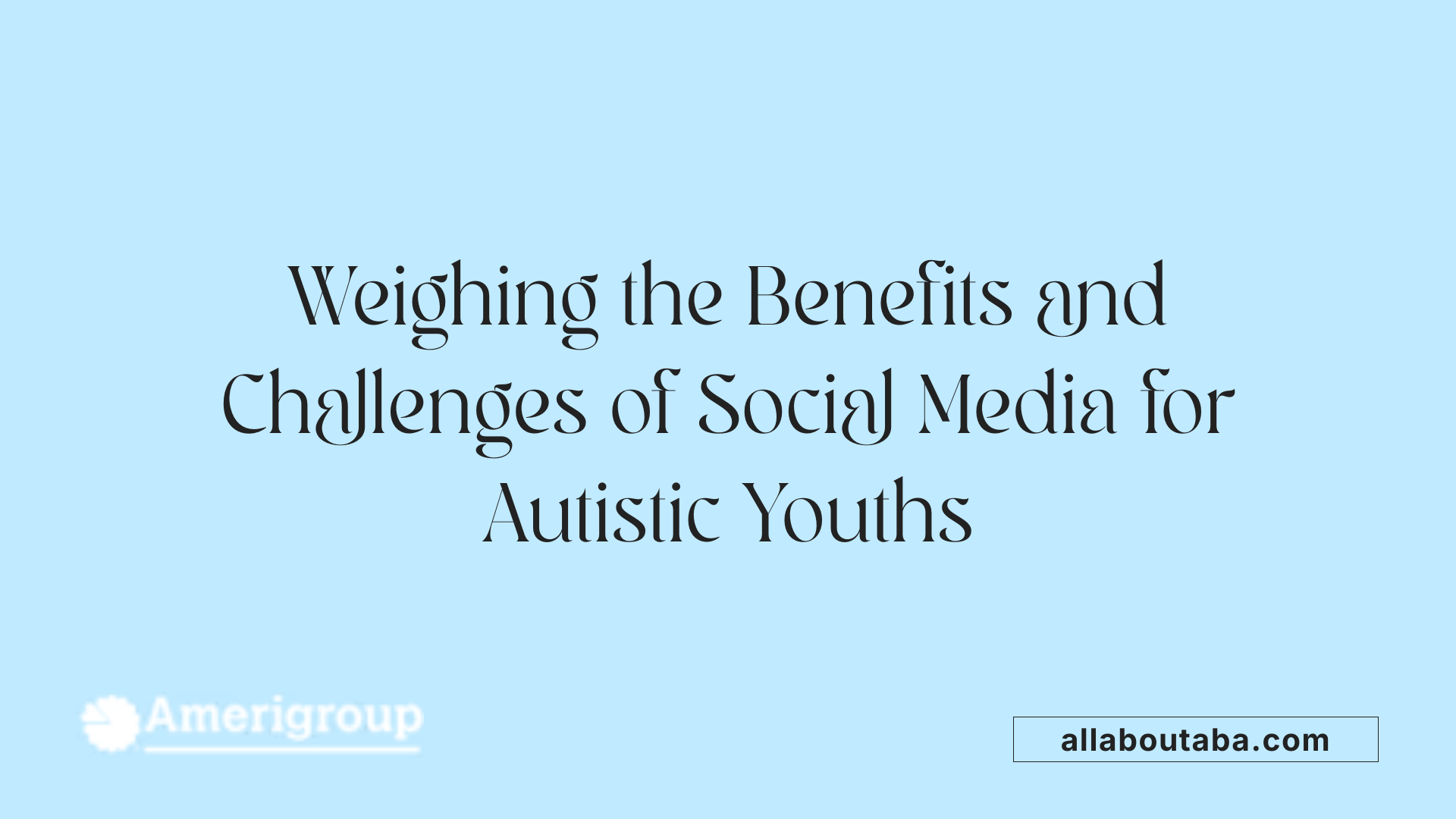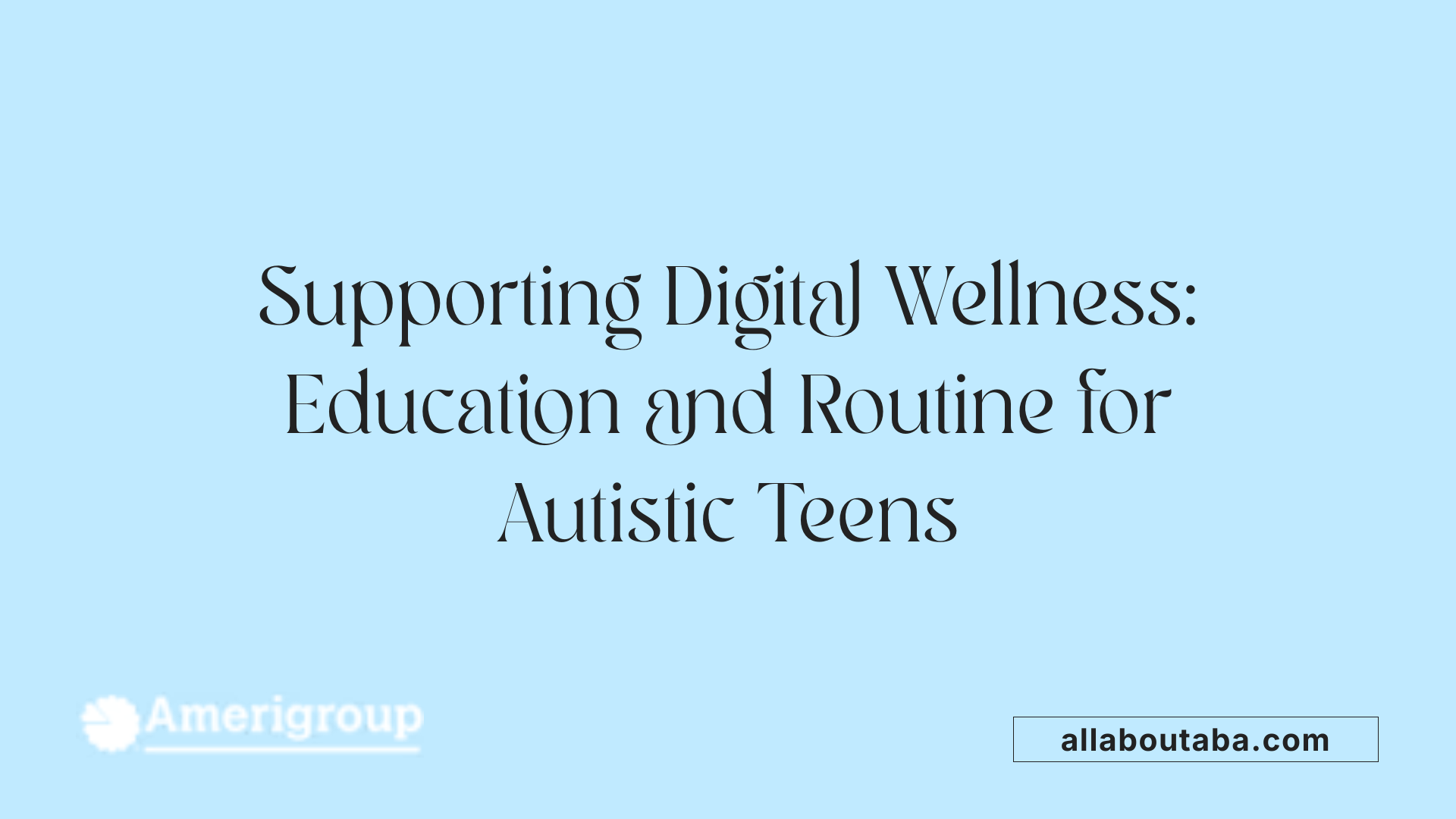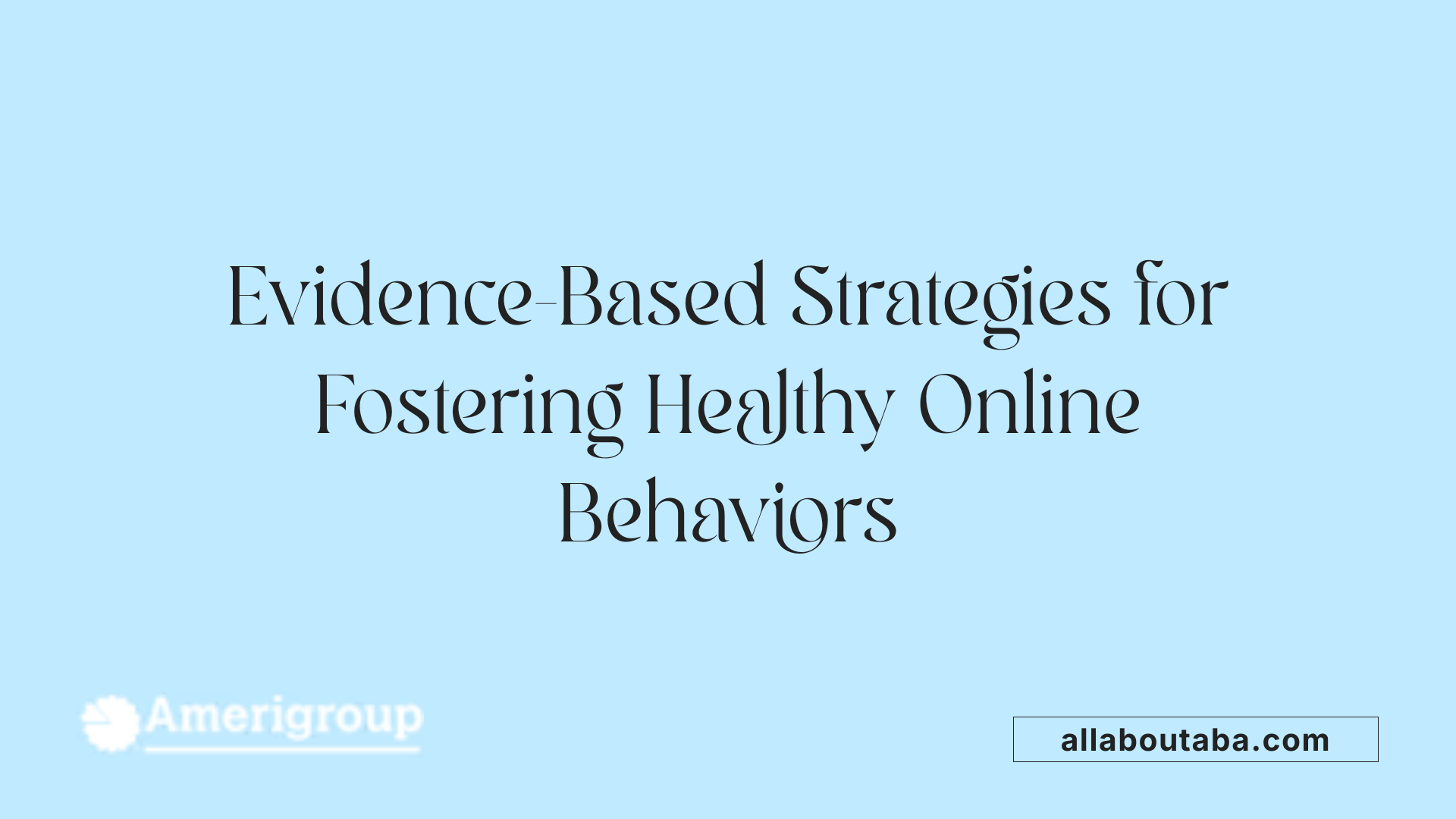Best Ways To Promote Healthy Social Media Use For Autistic Teens
Understanding the Balance of Benefits and Challenges
As digital platforms become central to social interaction, autistic teens find both meaningful opportunities and specific risks in social media. Recognizing the dual nature of these online spaces is crucial for fostering safe, supportive, and enriching experiences for autistic youth.
The Positive Impact of Social Media in the Autistic Community

How can social media benefit the autistic community, and what resources are available for safe and supportive engagement?
Social media provides numerous advantages for autistic individuals by fostering social connection and building supportive communities. It allows them to maintain friendships, explore shared interests, and express themselves in a less intimidating environment compared to face-to-face interactions.
Many autistic individuals use platforms like Facebook, TikTok, YouTube, and Discord to share artwork, advocate for autism rights, and connect with peers who understand their experiences. Online forums and support groups can help reduce feelings of isolation and provide a sense of belonging.
Interest-based engagement is another significant benefit. Creative apps and online communities enable autistic individuals to develop skills such as coding, storytelling, or sharing creative projects. These activities promote self-expression and confidence.
Advocacy and raising awareness are also empowered through social media. Many autistic people use these platforms to share their stories, influence policy changes, and foster understanding among the broader public. This self-advocacy supports increased acceptance and inclusion.
Online peer support is especially valuable for those with higher support needs. Connecting virtually allows for meaningful interactions that might be challenging in person, including support through AAC (Augmentative and Alternative Communication) or sharing artwork.
Despite these benefits, there are risks such as privacy concerns, online harassment, scams, and cyberbullying. To navigate these challenges, numerous resources are available. Educational programs from organizations like Common Sense Media teach digital literacy and online safety skills.
Support from families, caregivers, and educators is crucial. They can help set boundaries, monitor online activities, and encourage responsible behavior. Using tools like privacy settings, visual timers, and structured routines can also promote safe engagement.
In summary, while social media offers pronounced benefits for autistic community building and self-expression, it is essential to combine these opportunities with proper safeguards. With guidance and resources, autistic individuals can enjoy the positive impacts of online platforms while minimizing potential risks.
Resources for Safe Engagement:
- Online support groups and forums
- Social media literacy courses
- Educational content from organizations like Common Sense Media
- Parental and caregiver monitoring tools
- Safe practice platforms like Flip and Seesaw for social skill development
Through responsible use and ongoing education, social media can be a powerful tool to enhance social connections, advocacy, and personal growth within the autistic community.
Benefits & Challenges of Social Media Use for Autistic Youths

What are the benefits and challenges of social media use for autistic children and teens?
Social media offers a range of positive opportunities for autistic children and teens. It allows them to maintain connections with friends, family, and the broader community, which is especially important during times when in-person interactions are limited. Many autistic youth find online platforms a welcoming space to pursue shared interests, such as art, gaming, or advocacy, leading to increased happiness and a sense of belonging.
One significant advantage is the control over communication that social media provides. Many autistic individuals prefer typing over speaking, as it can reduce sensory overload and give them more time to craft their responses. Online interactions often lack the immediate social cues present in face-to-face conversations, making it easier for some to express themselves comfortably.
However, these benefits come with notable challenges. Autistic traits, like literal interpretation of content or difficulty recognizing social cues, can complicate online interactions. This may lead to misunderstandings or increased anxiety if messages are misinterpreted. Additionally, exposure to cyberbullying, harassment, and disinformation poses emotional risks. Youths with autism may also be more vulnerable to oversharing or misjudging online content, which can have adverse consequences.
To navigate these complexities, parental involvement and digital literacy education are vital. Setting boundaries and teaching responsible online behavior help safeguard autistic youth. Moreover, designing social media platforms with neurodiversity in mind—such as clearer privacy settings and customizable notification controls—can enhance safety and comfort. With proper support, social media can become a powerful tool for socialization, self-expression, and community-building among autistic youth.
Developing Skills for Safe and Responsible Social Media Use

What management strategies can help autistic teens navigate social media responsibly?
Helping autistic teenagers use social media safely involves a mix of education, skill development, and ongoing support. Parents and teachers should prioritize teaching digital literacy, which includes recognizing potential risks like scams, cyberbullying, and oversharing.
One effective approach is using visual tools such as timers and schedules. Visual prompts help teens understand limits on their screen time and behavior expectations. Establishing clear boundaries, such as designated tech-free times and supervised online activities, encourages responsible habits.
Gradually increasing independence while maintaining oversight allows teens to develop confidence and self-regulation skills. Communicating with teens openly about online experiences helps foster trust, enabling discussions about respecting others online and avoiding harmful content.
Incorporating social media into broader social-emotional learning supports responsible usage. Sharing positive media experiences and practicing digital citizenship in a controlled environment builds understanding and resilience.
By combining these strategies—visual aids, boundaries, education, and ongoing dialogue—parents and educators can equip autistic teens with the tools necessary for safe and meaningful online interactions.
Supporting Healthy Online Behaviors Through Education and Routine

What are effective strategies for supporting healthy social media use among autistic teens?
Supporting autistic teens in their social media habits involves a combination of establishing routines, providing education, and involving families and educators. Creating structured routines helps autistic adolescents develop responsible digital habits. Families can set clear boundaries such as designated times for social media use, ensuring a healthy balance with offline activities.
Teaching online safety is essential. This includes guiding teens on managing privacy settings, recognizing and reporting cyberbullying, and understanding appropriate online interactions. These lessons should be continuous and integrated into daily life, including socio-emotional and sexual health education, to foster a comprehensive understanding.
Using visual tools like schedules, timers, and prompts supports teens in adhering to media limits. Visual timers especially help children understand and respect boundaries, fostering self-regulation skills. Parental and educator monitoring further safeguards against risks like oversharing or exposure to harmful content.
Encouraging meaningful online interactions, such as engaging with shared interests and building friendships, can be beneficial. This promotes social skill development within a safe framework. However, it’s vital to address potential hazards like privacy issues and cyberbullying through open communication channels, guidance, and supervision.
In tailoring digital literacy education, focusing on individual interests and sensitivities enhances effectiveness. Promoting offline activities such as outdoor play, face-to-face socialization, and hobbies balances screen time.
Overall, an integrated approach involving routines, education, and continuous family and school support fosters healthy social media engagement. It empowers autistic teens to explore online social opportunities safely and confidently, promoting independence while minimizing risks.
Research Insights on Media Use and Developmental Impacts
What do research findings indicate about the impact of screen media on development and autism-like symptoms?
Research has shown that excessive use of screen media, especially during early childhood, can have significant effects on development. Studies associate high screen time with delays in language acquisition, social communication difficulties, and behaviors resembling autism, such as hyperactivity.
Early exposure to screens may trigger changes in the brain's structure and function. Neuroimaging research suggests that heavy media consumption can alter brain regions involved in mood regulation, attention, and social interaction. For instance, children with high screen use often exhibit less organized neural pathways, which could affect emotional and cognitive development.
Furthermore, intense screen time can disrupt biological rhythms, leading to sleep problems. Screen light impacts circadian rhythms and melatonin production, making it harder for children to maintain healthy sleep patterns—critical for overall growth.
While moderate and supervised media use can support learning and social connection, unstructured or excessive use correlates with more pronounced autism symptoms. This includes increased hyperactivity, social withdrawal, and reduced impulse control.
Research also indicates that reducing screen time and promoting face-to-face interactions can improve language skills and social behaviors, especially in children with ASD or autism-like symptoms. These findings highlight the importance of balanced media use in early development.
Although genetics play a central role in autism, environmental influences like media habits can impact developmental trajectories. Encouraging mindful use of screens and fostering real-world social interactions are crucial for supporting healthy growth.
| Aspect | Findings | Implications |
|---|---|---|
| Early media exposure | Linked to autism-like behaviors and delays | Limit early media exposure; promote play and interaction |
| Brain structure and function | Changes in neural organization with high media use | Foster activities that stimulate brain development |
| Sleep and circadian rhythms | Disrupted by screen light exposure | Establish tech-free zones, especially at night |
| Developmental interventions | Reduced screen time improves social and language skills | Monitor and regulate media habits actively |
In summary, a cautious approach to media consumption during early childhood, combined with active engagement in social and physical activities, supports healthier developmental outcomes and may reduce the severity of autism-like symptoms.
Implementing Evidence-Based Practices for Healthy Online Behaviors

What evidence-based practices promote healthy online behaviors in autistic adolescents?
Promoting safe and positive online experiences for autistic teens involves implementing practices grounded in current research and tailored to their unique needs. Digital literacy programs are fundamental, teaching autistic youth about responsible online use, understanding social cues, and managing privacy settings. These programs should be adapted to their developmental stage, ensuring that skills like recognizing cyberbullying, avoiding oversharing, and understanding online risks are clearly conveyed.
Personalized routines and guidelines play a vital role. Developing custom rules—such as limits on screen time and designated times for online activity—can be crafted through collaborative discussions with families, emphasizing respect for individual preferences and values. Visual schedules, timers, and visual prompts aid in establishing consistency and helping adolescents understand boundaries.
Monitoring tools and supervised interactions further support safe engagement. Apps and software that track online activity allow caregivers to oversee social media use, prevent late-night screen time, and identify potentially harmful behaviors like excessive gaming or exposure to inappropriate content. Setting clear boundaries, such as supervised use on specific devices or employing supervised platforms like Flip or Seesaw, helps maintain control while fostering independent skills.
Emerging approaches include targeted telehealth interventions and social media-based programs. These provide opportunities for remote social skills training, behavioral coaching, and peer interaction in a controlled environment. While high-quality evidence is limited, early studies indicate they can be effective in promoting social engagement and reducing online risks.
In summary, integrating caregiver education, personalized routines, technological monitoring tools, and innovative telehealth solutions creates a comprehensive, evidence-informed strategy. This approach supports autistic adolescents in developing healthy digital habits, gaining autonomy, and navigating online spaces safely and confidently.
Fostering Healthy Online Engagement in Autism
Supporting autistic teens in navigating social media involves a multi-layered approach that emphasizes education, boundaries, ongoing support, and community resources. By integrating these strategies into daily routines and educational frameworks, families, caregivers, and educators can foster safe, enriching, and empowering online experiences, facilitating social growth and wellbeing for autistic youth.
References
- Social Media Use and Autism - Teens and Adults
- Autistic Youth and Social Media | 700 Children's Blog
- How should I handle my child's media use if they ...
- Social Media Can Provide Connections for Children and ...
- Guiding Social Media Use With Young Autistic Students
- Early Childhood Screen Time, Brain Development, and ...
- Social media offers benefits for autistic community
- Social Media Use and Autism - Teens and Adults
- Autistic Youth and Social Media | 700 Children's Blog
Other articles
Recent articles

Best Practices For Autism-Friendly Fitness And Recreation Centers

Best Ways To Promote Healthy Social Media Use For Autistic Teens

How To Help Autistic Children Cope With Public Speaking

Autism And Strategies For Managing Unexpected Changes

Best Podcasts About Autism For Parents And Educators

Autism And The Impact Of Seasonal Changes On Behavior

The Role Of Diet In Managing Co-Occurring Conditions With Autism

Sleep Challenges In Autism And Practical Solutions

Best Ways To Build Daily Routines For Autistic Children

Best Practices For Supporting Autistic Entrepreneurs

Autism And Strategies For Navigating Large Social Gatherings

Adaptive Sports And Recreational Activities For People With Autism

Autism And The Benefits Of Story-Based Learning Activities

Understanding The Role Of Play In Autism Development

Autism And The Impact Of Environmental Noise On Learning

How To Create Autism-Friendly Community Spaces

Autism And Chronic Health Conditions: What To Know

The Role Of Care Managers In Autism Life Planning

How To Teach Social Boundaries To Autistic Children

How Autistic Individuals Experience Empathy Differently

How To Support Autistic Employees In Remote Work Settings

Autism And The Relationship Between Motor Skills And Learning

How To Create Community Resource Guides For Autism Families

How To Teach Daily Living Skills To Autistic Teens

Autism And The Impact Of Mind-Body Practices On Stress Reduction

Autism And The Benefits Of Outdoor Group Activities

How To Create Autism-Friendly Sensory Paths In Schools

Best Practices For Autism-Friendly Park And Recreation Areas

Autism And Strategies For Reducing School Refusal

Supporting Autistic Individuals In Public Speaking

The Role Of Diet In Managing Autism Symptoms

The Benefits Of Gardening Clubs For Autism Social Development

How To Prepare Autistic Children For Dental Visits

Autism And Employment: Career Paths That Work

Best Practices For Autism-Friendly Hotels And Lodging

The Impact Of Screen Time On Autism Development

Autism Screening Tools For Early Childhood

The Role Of Physical Exercise In Autism Therapy

Best Strategies For Supporting Autistic College Students

The Role Of Technology In Autism Early Detection

Sensory-Friendly Classroom Design Ideas For Autistic Students

The Role Of Speech Therapy In Building Social Communication Skills

Best Strategies For Handling Autistic Burnout In Adults

Autism And The Importance Of Predictability In Routine

Autism And Peer Education: Teaching Acceptance In Schools

Best Practices For Sensory-Friendly Libraries And Reading Rooms

Self-Advocacy Skills For Autistic Adults

The Role Of Technology In Autism Peer Communication

Promoting Physical Activity In Children With Autism

How To Prepare Autistic Children For Medical Procedures

The Role Of Social Media In Autism Advocacy And Awareness

The Impact Of Sensory Rooms In Public Facilities For Autism

How To Create An Autism-Friendly Holiday Celebration

Best Practices For Inclusive Education For Autistic Students

Autism And Mental Health: Recognizing Signs Of Distress

Best Practices For Sensory-Friendly Waiting Rooms

The Role Of Teachers In Early Autism Red Flag Identification

Autism-Friendly Housing Design Features

Autism-Friendly Housing Design Features

How Environmental Modifications Improve Autism Outcomes

Autism And Technology-Based Learning Tools

Supporting Autistic Children Through Changes In Routine

The Link Between Autism And Working Memory Challenges

Best Practices For Autism-Friendly Cooking Classes

Autism And The Benefits Of Structured Music Lessons

Best Books To Teach Kids About Autism Acceptance

Sensory Diets And Their Benefits For Autism Management

How To Prepare Autistic Teens For Driver’s Education

How To Teach Autistic Teens About Healthy Relationships

The Role Of Visual Prompts In Building Daily Habits For Autism

Addressing Sleep Regression In Children With Autism

Understanding Social Stories And How They Help Autistic Children

Navigating Insurance Coverage For Autism Therapy Services

How To Prepare Autistic Adults For Independent Travel

Supporting Autistic Individuals In Volunteer Work

How Mindfulness Practices Can Support Autism Well-Being

Understanding Hyperfocus And Special Interests In Autism

Understanding Stimming As A Self-Regulation Tool

Sensory-Based Interventions For Autism At Home

Best Ways To Introduce Self-Advocacy In Autistic Teens

Best Ways To Support Autistic Employees In Customer Service Roles

Best Practices For Autism-Friendly Volunteer Programs

Autism And The Benefits Of Sensory Play For Emotional Growth

Autism And Strategies For Building Peer Relationships

Understanding How Autism Affects Memory Processing

Autism And Strategies For Building Coping Skills In Teens

The Role Of Parent Training In Autism Intervention Programs

Autism-Friendly Workplace Accommodations

Using Visual Timers For Autism Time Management

What Is ABA Therapy?

Autism and Sleep

Do Plastic Toys Cause Autism?

Autism Facial Expressions

Autism and Motor Skills

Which Parent Carries The Autism Gene?

Autism Symbols & Colors

Rett Syndrome: Symptoms, Causes, and Treatment

Self-Diagnosed Autism

Autism and Sound Sensitivity

Autism With Speech Delay
We’re All About You, Your Family, and Your Child

